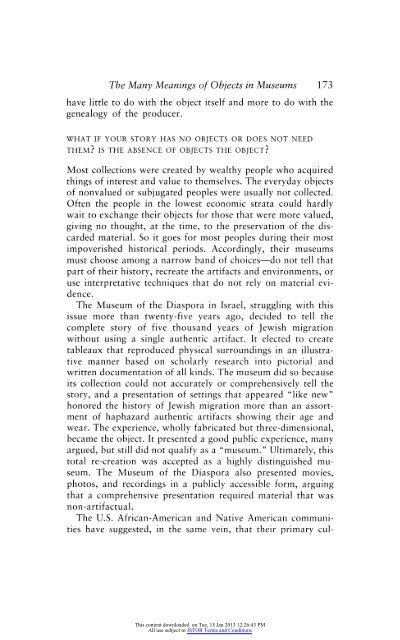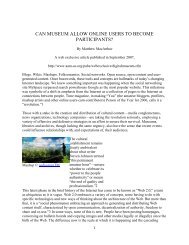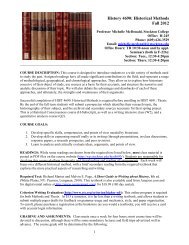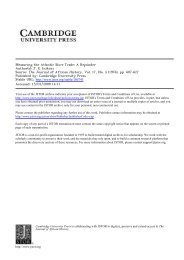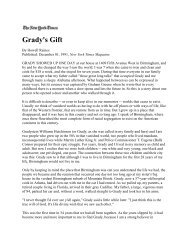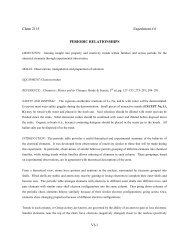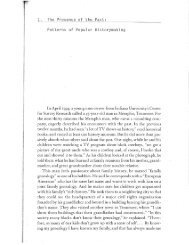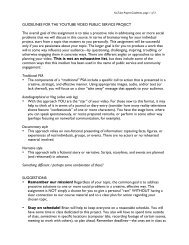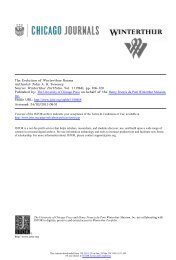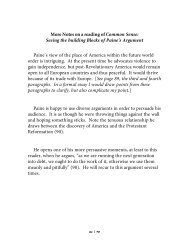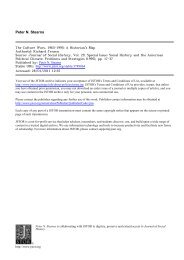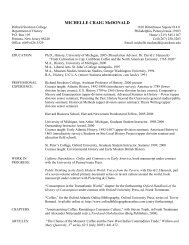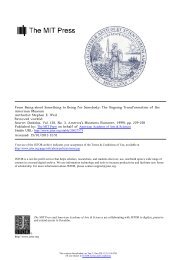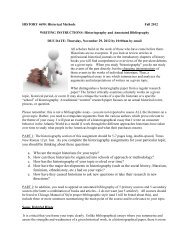What Is the Object of This Exercise? A Meandering Exploration of ...
What Is the Object of This Exercise? A Meandering Exploration of ...
What Is the Object of This Exercise? A Meandering Exploration of ...
You also want an ePaper? Increase the reach of your titles
YUMPU automatically turns print PDFs into web optimized ePapers that Google loves.
The Many Meanings <strong>of</strong> <strong>Object</strong>s in Museums 173<br />
have little to do with <strong>the</strong> object itself and more to do with <strong>the</strong><br />
genealogy <strong>of</strong> <strong>the</strong> producer.<br />
WHAT IF YOUR STORY HAS NO OBJECTS OR DOES NOT NEED<br />
THEM? IS THE ABSENCE OF OBJECTS THE OBJECT?<br />
Most collections were created by wealthy people who acquired<br />
things <strong>of</strong> interest and value to <strong>the</strong>mselves. The everyday objects<br />
<strong>of</strong> nonvalued or<br />
subjugated peoples<br />
were<br />
usually<br />
not collected.<br />
Often <strong>the</strong> people<br />
in <strong>the</strong> lowest economic strata could hardly<br />
wait to<br />
exchange <strong>the</strong>ir objects for those that were more<br />
valued,<br />
giving<br />
no<br />
thought,<br />
at <strong>the</strong> time, to <strong>the</strong> preservation <strong>of</strong> <strong>the</strong> dis<br />
carded material. So it goes for most<br />
peoples during <strong>the</strong>ir most<br />
impoverished historical periods. Accordingly, <strong>the</strong>ir museums<br />
must choose among a narrow band <strong>of</strong> choices?do not tell that<br />
part <strong>of</strong> <strong>the</strong>ir history,<br />
recreate <strong>the</strong> artifacts and environments, or<br />
use<br />
interpretative techniques that do not<br />
rely<br />
on material evi<br />
dence.<br />
The Museum <strong>of</strong> <strong>the</strong> Diaspora<br />
in <strong>Is</strong>rael, struggling with this<br />
issue more than twenty-five years ago, decided to tell <strong>the</strong><br />
complete story <strong>of</strong> five thousand years <strong>of</strong> Jewish migration<br />
without using<br />
a<br />
single au<strong>the</strong>ntic artifact. It elected to create<br />
tableaux that reproduced physical surroundings<br />
in an illustra<br />
tive manner based on<br />
scholarly research into pictorial and<br />
written documentation <strong>of</strong> all kinds. The museum did so because<br />
its collection could not<br />
accurately<br />
or<br />
comprehensively tell <strong>the</strong><br />
story, and a<br />
presentation <strong>of</strong> settings that appeared "like new"<br />
honored <strong>the</strong> history <strong>of</strong> Jewish migration<br />
more than an assort<br />
ment <strong>of</strong> haphazard au<strong>the</strong>ntic artifacts showing <strong>the</strong>ir age and<br />
wear. The experience, wholly fabricated but three-dimensional,<br />
became <strong>the</strong> object. It presented<br />
a<br />
good public experience, many<br />
argued, but still did not<br />
qualify<br />
as a "museum." Ultimately, this<br />
total re-creation was<br />
accepted<br />
as a<br />
highly distinguished<br />
mu<br />
seum. The Museum <strong>of</strong> <strong>the</strong> Diaspora also presented movies,<br />
photos, and recordings<br />
in a<br />
publicly accessible form, arguing<br />
that a<br />
comprehensive presentation required material that was<br />
non-artifactual.<br />
The U.S. African-American and Native American communi<br />
ties have suggested, in <strong>the</strong> same vein, that <strong>the</strong>ir primary cul<br />
<strong>This</strong> content downloaded on Tue, 15 Jan 2013 12:26:43 PM<br />
All use subject to JSTOR Terms and Conditions


